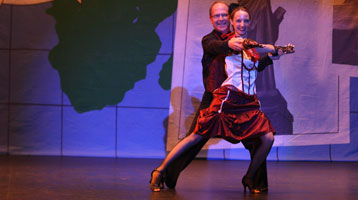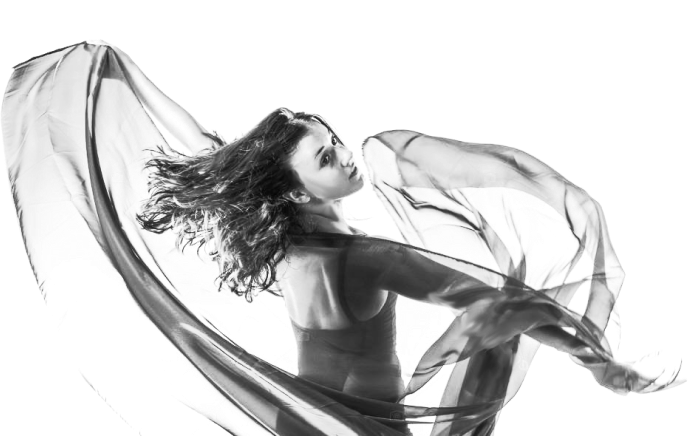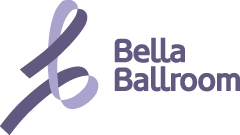
Latin Dance
Jive
The Jive is lively and fast-paced dance that is typically danced to up-beat swing or contemporary music. In the competitive ballroom dancing communities, the Jive is considered a Latin dance, however, it also belongs to the swing dancing family. It’s a popular dance on shows such as, “So You Think You Can Dance” and “Dancing with the Stars.”
History of the Jive:
The Jive has been around for nearly one hundred years, and has evolved and changed throughout its lifetime. When looking at the history of Jive dancing it’s important to note that it’s development in each country and within each generation has varied so it is not uncommon to get different answers when you ask people what the Jive is. There are at least three different main threads of the Jive. The first style is celebrated by those who love the music, fashion, and style of the traditional style of Jive which has also been called Lindy Hop, Jitterbug, and Rock ‘n Roll, among other names. Another style of the Jive is Ballroom Jive and is danced in ballrooms and ballroom dance studios. The third style of the Jive is danced at local dance clubs and is known Modern Jive, Ceroc, Le Roc or French Jive.
The strongest and oldest dance lineage of the Jive dates back to the dance genre known as Lindy Hop. The Lindy Hop was first named in 1927. Lindy Hop drew on previously existing dance styles and combined them in a unique manner that combined both open and closed positions with dancer’s improvisations to the syncopated rhythms of swing music.
The word “jive” was slang often associated swing music and early jazz, as well as imitation, exaggeration, and foolish talk. It’s possible the word “jive” came from the English “Jibe,” meaning to change course by swinging a sail across a following wind, or the West African “jev.” The phrase “they’re just jiving,” meaning they’re just fooling around, was probably mistaken to mean the actual name of a dance. The singer and bandleader Cab Calloway made the word more widely known to the public when he associated it with swing and published it in the first African-American slang dictionary. The New Cab Calloway’s Hepsters Dictionary: The Language of Jive was published in 1938, but the word “Jive” was associated with the dance closer to 1934. The Jive was also called the “Jitterbug Jive” and was a category of dance in the 1935 dance competitions hosted in New York City at the annual “Harvest Moon Ball.” The word “Jitterbug,” is believed to be coined by Cab Calloway’s band’s trombonist Harry White who described dancers as moving “like the frenzy of jittering bugs.” Later, trumpeter Edwin Swaysee wrote a song titled “Jitterbug” that became a huge hit and made “Jitterbug” a household name.
Throughout the 1930s, the Jitterbug Jive expanded into different styles including dances that added six-beat patterns and adapted to various speeds of music. Dancers began to include personal touches including tap steps, jazz moves, acrobatics, ariels and more. The 1940s brought a lot of change to the Jive. American GIs increased the influence of American Jive on Europe. The UK developed a style of Jive in the 1940s that was simpler and used mostly six or four beat patterns with lots of repetition. In the U.S., the dance continued to evolve in a variety of directions. The region, music style, and dancers influenced the Jive informally in dance halls and more formally in dance schools. The “Jive,” also known as “Jitterbug”, began to be called “Rock ‘n’ Roll” as Bill Haley’s hit record Rock Around the Clock released in 1956.
Jive dancing continued to develop and evolve spawning different styles and dance techniques in the various countries the popular dance became known in around the world.
Jive Dance Today
“Jive” is still often used as a generic term to describe the various styles of swing dancing. Jive dancing has evolved to adopt moves and influences from Lindy Hop, swing, boogie-woogie, B-bop, Le Pop, Rock ‘n Roll, Hustle, Hollywood style, West Coast Swing, Shag, Push, Whip, Jitterbug, Disco and more.
In competitive ballroom dancing, the Jive is one of five International Latin dances. Many of its basic patterns are similar to those of the East Coast Swing, but the Jive tends to be danced to a faster and highly syncopated rhythm. The Jive has a high lift of the knees, upbeat steps and swinging hip motion. Often times, dancers competing in the International Latin dances will compete in samba, rumba, paso doble, and Cha Cha before having their stamina tested in a Jive dance. Today the Jive is controlled by organizations like ISTD, IDTA, and UKA. These organizations all have their own syllabus for the Jive to provide framework for competing dancers so they can be awarded bronze, silver, and gold medals acknowledging their skills worldwide. In general, Ballroom Jive is taught along with the rest of the Latin American syllabus.
Today, the Jive is embraced in a variety of forms under a variety of names. The dance continues to evolve with the changing music industry. “Modern Jive” includes dances known as “Ceroc,” “Le Rock,” “Le Jive,” “Mo’jive,” “Salsa-Jive,’ “Smooth Jive,” “Le Bop,” “Cool Jive,” “Le Step,” “Night Club Jive” among others that are being created. While some dancer embraces the emerging styles of the jive, others continue to hold on to the traditional styling of the dance.
Jive Dance Music
- “In the Mood” Glen Miller Orchestra
- “Big Time Operator” Big Bad Voodoo Daddy
- “Candy Man” Christina Aguilera
- “Let’s Do It Again” Kevin Mark
- “The Walkin’ Song” Royal Crown Revue
- “Whistle Stop” Louis Prima
- “Tennessee” Bob Sinclar
- “C’est La Vie” Bob Seger
- “Moves Like Jagger” Maroon 5 featuring Christina Aguilera
- “Wake Me Up” Helene Fischer
- “Workin’ For a Livin’” Huey Lewis & the News
- “Runaround Sue” Dion
- “Wade in Water” Eva Cassidy
- “Drive By” Train
- “Goodbye to You” Scandal
- “Roll Over Beethoven” The Beatles
- “Domino” Jessie J
- “Need You Now” Lady Antebellum
- “I Saw Her Standing There” The Beatles
- “Sk8er Boi” Avril Lavigne
- “Rock & Roll Music” Chuck Berry
- “I’m a Believer” Smash Mouth
- “Willie and the Hand Jive” Johnny Otis
- “Let the Little Girl Dance” Carl Glover
- “The Girl’s Gone Wild” Travis Tritt
- “Get a Job” The Silhouettes
- “Jump Jive An’ Wail” The Brian Setzer Orchestra
- “Rock Around the Clock” Bill Haley & The Comets
- “Your Mama Don’t Dance” Poison
- “Crazy Little Thing Called Love” Queen
- “Hit The Road Jack” Buster Poindexter
- “Fun Fun Fun” The Beach Boys
- “Heat Wave” Marth & the Vandellas
- “Goody Two Shoes” Adam Ant
- “Blurred Lines” Robin Thicke
- “Walks Like Rihanna” The Wanted
- “I Love It “ Icona Pop
- “Mercy” Duffy
- “Swing the Mood” Jive Bunny & the Mastermixers
- “All Shook Up” Elvis Presley


